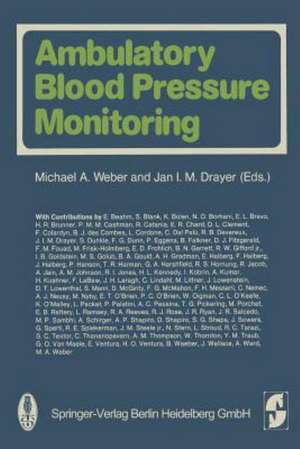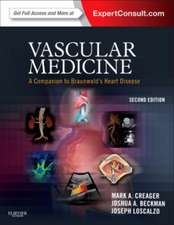Ambulatory Blood Pressure Monitoring
Editat de M.D. Weber, I.J. Drayeren Limba Engleză Paperback – 22 dec 2012
Preț: 366.70 lei
Preț vechi: 386.00 lei
-5% Nou
Puncte Express: 550
Preț estimativ în valută:
70.17€ • 72.85$ • 58.52£
70.17€ • 72.85$ • 58.52£
Carte tipărită la comandă
Livrare economică 22 martie-05 aprilie
Preluare comenzi: 021 569.72.76
Specificații
ISBN-13: 9783662056875
ISBN-10: 3662056879
Pagini: 260
Ilustrații: IX, 249 p. 108 illus.
Dimensiuni: 155 x 235 x 17 mm
Greutate: 0.37 kg
Ediția:Softcover reprint of the original 1st ed. 1984
Editura: Steinkopff
Colecția Steinkopff
Locul publicării:Heidelberg, Germany
ISBN-10: 3662056879
Pagini: 260
Ilustrații: IX, 249 p. 108 illus.
Dimensiuni: 155 x 235 x 17 mm
Greutate: 0.37 kg
Ediția:Softcover reprint of the original 1st ed. 1984
Editura: Steinkopff
Colecția Steinkopff
Locul publicării:Heidelberg, Germany
Public țintă
Professional/practitionerCuprins
Section I: Techniques.- Ambulatory blood pressure monitoring: recorders, applications and analyses.- Ambulatory blood pressure — direct and indirect.- Can short-term recording of blood pressure in supine patients replace ambulatory blood pressure monitoring.- Ambulatory blood pressure monitoring: methods to assess severity of hypertension, variability and sleep changes.- Interfacing the Del Mar Avionics Model 1978 PIII system with the Apple IIe computer.- Blood pressure fluctuation and amplitude in normal human subjects.- Accuracy and reproducibility of ambulatory blood pressure recorder measurements during rest and exercise.- Adaptation to non-invasive continuous blood pressure monitoring.- Accuracy, reproducibility and usefulness of ambulatory blood pressure recording obtained with the Remler system.- Reproducibility of ambulatory blood pressure recordings.- Blood pressure measurement in an ambulatory setting.- Home and office blood pressures. Clinical observations and hemodynamic mechanisms.- Home vs clinic blood pressure in essential hypertension with and without behavioral therapy.- Aerospace applications of ambulatory blood pressure monitoring.- Section II: Physiology.- Understanding hypertension. The contribution of direct ambulatory blood pressure monitoring.- Ambulatory blood pressure in 199 normal subjects, a collaborative study.- Non-invasive automated blood pressure monitoring in ambulatory normotensive men.- Chronobiologic assessment of human blood pressure variation in health and disease.- The effect of age on circadian rhythm of blood pressure, catecholamines, plasma renin activity, prolactin and corticosteroids in essential hypertension.- Blood pressure monitors in studies of cardiovascular response.- Familial influences on ambulatory blood pressure:studies of normotensive twins.- The role of ambulatory blood pressure monitoring in the evaluation of adolescent hypertension induced by exercise.- Essential hypertension in the elderly: circadian variation of arterial pressure.- Non-invasive assessment of cardiac anatomy and blood pessure in patients with borderline hypertension.- Ambulatory monitoring of blood pressure: the importance of blood pressure during work.- Usefulness of several devices for intermittent blood pressure monitoring in the assessment of the efficacy of antihypertensive therapy.- Section III: Therapy.- Blood pressure variability in hypertensive patients during and immediately following treatment with propranolol and clonidine.- Evaluation of the posology of pindolol therapy of hypertension with automatic indirect ambulatory blood pressure monitoring.- A comparison of once daily and twice daily antihypertensive therapy with enalapril using noninvasive ambulatory BP monitoring.- Continuous blood pressure monitoring in the evaluation of the effectiveness of antihypertensive drugs.- Intra-arterial ambulatory blood pressure monitoring in the assessment of antihypertensive drugs.- Effects of atenolol on 24-hour arterial pressure and heart rate in essential hypertension.- Authors’ Index.









